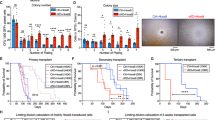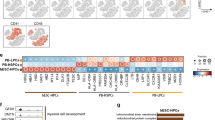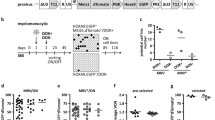Abstract
The MLL–AF9 fusion gene is associated with aggressive leukemias of both the myeloid and lymphoid lineage in infants, whereas in adults, this translocation is mainly associated with acute myeloid leukemia. These observations suggest that differences exist between fetal and adult tissues in terms of the ‘cell of origin’ from which the leukemia develops. Here we show that depending on extrinsic cues, human neonatal CD34+ cells are readily immortalized along either the myeloid or lymphoid lineage upon MLL–AF9 expression and give rise to mainly lymphoid leukemia in immunocompromised mice. In contrast, immortalization of adult bone marrow CD34+ cells is more difficult to achieve and is myeloid-biased, even when MLL–AF9 is expressed in purified hematopoietic stem cells (HSCs). Transcriptome analysis identified enrichment of HSC but not progenitor gene signatures in MLL–AF9-expressing cells. Although not observed in adult cells, neonatal cells expressing MLL–AF9 were enriched for gene signatures associated with poor prognosis, resistance to chemotherapeutic agents and MYC signaling. These results indicate that neonatal cells are inherently more prone to MLL–AF9-mediated immortalization than adult cells and suggest that intrinsic properties of the cell of origin, in addition to extrinsic cues, dictate lineage of the immortalized cell.
This is a preview of subscription content, access via your institution
Access options
Subscribe to this journal
Receive 12 print issues and online access
$259.00 per year
only $21.58 per issue
Buy this article
- Purchase on SpringerLink
- Instant access to full article PDF
Prices may be subject to local taxes which are calculated during checkout




Similar content being viewed by others
References
Muntean AG, Hess JL . The pathogenesis of mixed-lineage leukemia. Ann Rev Pathol 2012; 7: 283–301.
Pui CH, Gaynon PS, Boyett JM, Chessells JM, Baruchel A, Kamps W et al. Outcome of treatment in childhood acute lymphoblastic leukaemia with rearrangements of the 11q23 chromosomal region. Lancet 2002; 359: 1909–1915.
Eguchi M, Eguchi-Ishimae M, Greaves M . The role of the MLL gene in infant leukemia. Int J Hematol 2003; 78: 390–401.
Pui CH, Frankel LS, Carroll AJ, Raimondi SC, Shuster JJ, Head DR et al. Clinical characteristics and treatment outcome of childhood acute lymphoblastic leukemia with the t(4;11)(q21;q23): a collaborative study of 40 cases. Blood 1991; 77: 440–447.
Cozzio A, Passegue E, Ayton PM, Karsunky H, Cleary ML, Weissman IL . Similar MLL-associated leukemias arising from self-renewing stem cells and short-lived myeloid progenitors. Genes Dev 2003; 17: 3029–3035.
So CW, Karsunky H, Passegue E, Cozzio A, Weissman IL, Cleary ML . MLL-GAS7 transforms multipotent hematopoietic progenitors and induces mixed lineage leukemias in mice. Cancer Cell 2003; 3: 161–171.
Cumano A, Paige CJ, Iscove NN, Brady G . Bipotential precursors of B cells and macrophages in murine fetal liver. Nature 1992; 356: 612–615.
Horton SJ, Grier DG, McGonigle GJ, Thompson A, Morrow M, De Silva I et al. Continuous MLL-ENL expression is necessary to establish a “Hox Code” and maintain immortalization of hematopoietic progenitor cells. Cancer Res 2005; 65: 9245–9252.
Horton SJ, Walf-Vorderwulbecke V, Chatters SJ, Sebire NJ, de Boer J, Williams O . Acute myeloid leukemia induced by MLL-ENL is cured by oncogene ablation despite acquisition of complex genetic abnormalities. Blood 2009; 113: 4922–4929.
Zuber J, Rappaport AR, Luo W, Wang E, Chen C, Vaseva AV et al. An integrated approach to dissecting oncogene addiction implicates a Myb-coordinated self-renewal program as essential for leukemia maintenance. Genes Dev 2011; 25: 1628–1640.
Barabe F, Kennedy JA, Hope KJ, Dick JE . Modeling the initiation and progression of human acute leukemia in mice. Science 2007; 316: 600–604.
Rodriguez-Perales S, Cano F, Lobato MN, Rabbitts TH . MLL gene fusions in human leukaemias: in vivo modelling to recapitulate these primary tumourigenic events. Int J Hematol 2008; 87: 3–9.
Wei J, Wunderlich M, Fox C, Alvarez S, Cigudosa JC, Wilhelm JS et al. Microenvironment determines lineage fate in a human model of MLL–AF9 leukemia. Cancer Cell 2008; 13: 483–495.
Krivtsov AV, Armstrong SA . MLL translocations, histone modifications and leukaemia stem-cell development. Nat Rev Cancer 2007; 7: 823–833.
Meyer C, Schneider B, Jakob S, Strehl S, Attarbaschi A, Schnittger S et al. The MLL recombinome of acute leukemias. Leukemia 2006; 20: 777–784.
Rizo A, Horton SJ, Olthof S, Dontje B, Ausema A, van Os R et al. BMI1 collaborates with BCR-ABL in leukemic transformation of human CD34+ cells. Blood 2010; 116: 4621–4630.
Mulloy JC, Cammenga J, Berguido FJ, Wu K, Zhou P, Comenzo RL et al. Maintaining the self-renewal and differentiation potential of human CD34+ hematopoietic cells using a single genetic element. Blood 2003; 102: 4369–4376.
Krivtsov AV, Twomey D, Feng Z, Stubbs MC, Wang Y, Faber J et al. Transformation from committed progenitor to leukaemia stem cell initiated by MLL–AF9. Nature 2006; 442: 818–822.
Krivtsov AV, Feng Z, Armstrong SA . Transformation from committed progenitor to leukemia stem cells. Ann NY Acad Sci 2009; 1176: 144–149.
Ross ME, Mahfouz R, Onciu M, Liu HC, Zhou X, Song G et al. Gene expression profiling of pediatric acute myelogenous leukemia. Blood 2004; 104: 3679–3687.
Valk PJ, Verhaak RG, Beijen MA, Erpelinck CA, Barjesteh van Waalwijk van Doorn-Khosrovani S, Boer JM et al. Prognostically useful gene-expression profiles in acute myeloid leukemia. N Engl J Med 2004; 350: 1617–1628.
Wong DJ, Liu H, Ridky TW, Cassarino D, Segal E, Chang HY . Module map of stem cell genes guides creation of epithelial cancer stem cells. Cell Stem Cell 2008; 2: 333–344.
Ivanova NB, Dimos JT, Schaniel C, Hackney JA, Moore KA, Lemischka IR . A stem cell molecular signature. Science 2002; 298: 601–604.
Jaatinen T, Hemmoranta H, Hautaniemi S, Niemi J, Nicorici D, Laine J et al. Global gene expression profile of human cord blood-derived CD133+ cells. Stem Cells 2006; 24: 631–641.
Novershtern N, Subramanian A, Lawton LN, Mak RH, Haining WN, McConkey ME et al. Densely interconnected transcriptional circuits control cell states in human hematopoiesis. Cell 2011; 144: 296–309.
Eppert K, Takenaka K, Lechman ER, Waldron L, Nilsson B, van GP et al. Stem cell gene expression programs influence clinical outcome in human leukemia. Nat Med 2011; 17: 1086–1093.
Somervaille TC, Matheny CJ, Spencer GJ, Iwasaki M, Rinn JL, Witten DM et al. Hierarchical maintenance of MLL myeloid leukemia stem cells employs a transcriptional program shared with embryonic rather than adult stem cells. Cell Stem Cell 2009; 4: 129–140.
Kim J, Woo AJ, Chu J, Snow JW, Fujiwara Y, Kim CG et al. A Myc network accounts for similarities between embryonic stem and cancer cell transcription programs. Cell 2010; 143: 313–324.
Neff T, Sinha AU, Kluk MJ, Zhu N, Khattab MH, Stein L et al. Polycomb repressive complex 2 is required for MLL–AF9 leukemia. Proc Natl Acad Sci USA 2012; 109: 5028–5033.
Muller-Sieburg CE, Cho RH, Thoman M, Adkins B, Sieburg HB . Deterministic regulation of hematopoietic stem cell self-renewal and differentiation. Blood 2002; 100: 1302–1309.
Dykstra B, Kent D, Bowie M, McCaffrey L, Hamilton M, Lyons K et al. Long-term propagation of distinct hematopoietic differentiation programs in vivo. Cell Stem Cell 2007; 1: 218–229.
Benz C, Copley MR, Kent DG, Wohrer S, Cortes A, Aghaeepour N et al. Hematopoietic stem cell subtypes expand differentially during development and display distinct lymphopoietic programs. Cell Stem Cell 2012; 10: 273–283.
Johnson JJ, Chen W, Hudson W, Yao Q, Taylor M, Rabbitts TH et al. Prenatal and postnatal myeloid cells demonstrate stepwise progression in the pathogenesis of MLL fusion gene leukemia. Blood 2003; 101: 3229–3235.
Lavau C, Szilvassy SJ, Slany R, Cleary ML . Immortalization and leukemic transformation of a myelomonocytic precursor by retrovirally transduced HRX-ENL. EMBO J 1997; 16: 4226–4237.
Chen W, O'Sullivan MG, Hudson W, Kersey J . Modeling human infant MLL leukemia in mice: leukemia from fetal liver differs from that originating in postnatal marrow. Blood 2011; 117: 3474–3475.
Bowie MB, McKnight KD, Kent DG, McCaffrey L, Hoodless PA, Eaves CJ . Hematopoietic stem cells proliferate until after birth and show a reversible phase-specific engraftment defect. J Clin Invest 2006; 116: 2808–2816.
Groen RW, Noort WA, Raymakers RA, Prins HJ, Aalders L, Hofhuis FM et al. Reconstructing the human hematopoietic niche in immunodeficient mice: opportunities for studying primary multiple myeloma. Blood 2012; 120: e9–e16.
Ayton PM, Cleary ML . Transformation of myeloid progenitors by MLL oncoproteins is dependent on Hoxa7 and Hoxa9. Genes Dev 2003; 17: 2298–2307.
Faber J, Krivtsov AV, Stubbs MC, Wright R, Davis TN, Heuvel-Eibrink M et al. HOXA9 is required for survival in human MLL-rearranged acute leukemias. Blood 2009; 113: 2375–2385.
Wong P, Iwasaki M, Somervaille TC, So CW, Cleary ML . Meis1 is an essential and rate-limiting regulator of MLL leukemia stem cell potential. Genes Dev 2007; 21: 2762–2774.
Zuber J, Radtke I, Pardee TS, Zhao Z, Rappaport AR, Luo W et al. Mouse models of human AML accurately predict chemotherapy response. Genes Dev 2009; 23: 877–889.
Schreiner S, Birke M, Garcia-Cuellar MP, Zilles O, Greil J, Slany RK . MLL-ENL causes a reversible and myc-dependent block of myelomonocytic cell differentiation. Cancer Res 2001; 61: 6480–6486.
Bergerson RJ, Collier LS, Sarver AL, Been RA, Lugthart S, Diers MD et al. An insertional mutagenesis screen identifies genes that cooperate with MLL–AF9 in a murine leukemogenesis model. Blood 2012; 119: 4512–4523.
Mizukawa B, Wei J, Shrestha M, Wunderlich M, Chou FS, Griesinger A et al. Inhibition of Rac GTPase signaling and downstream prosurvival Bcl-2 proteins as combination targeted therapy in MLL–AF9 leukemia. Blood 2011; 118: 5235–5245.
Robinson BW, Behling KC, Gupta M, Zhang AY, Moore JS, Bantly AD et al. Abundant anti-apoptotic BCL-2 is a molecular target in leukaemias with t(4;11) translocation. Br J Haematol 2008; 141: 827–839.
Kvinlaug BT, Chan WI, Bullinger L, Ramaswami M, Sears C, Foster D et al. Common and overlapping oncogenic pathways contribute to the evolution of acute myeloid leukemias. Cancer Res 2011; 71: 4117–4129.
Lee AK, Ahn SG, Yoon JH, Kim SA . Sox4 stimulates ss-catenin activity through induction of CK2. Oncol Rep 2011; 25: 559–565.
Wang Y, Krivtsov AV, Sinha AU, North TE, Goessling W, Feng Z et al. The Wnt/beta-catenin pathway is required for the development of leukemia stem cells in AML. Science 2010; 327: 1650–1653.
Yeung J, Esposito MT, Gandillet A, Zeisig BB, Griessinger E, Bonnet D et al. beta-Catenin mediates the establishment and drug resistance of MLL leukemic stem cells. Cancer Cell 2010; 18: 606–618.
Acknowledgements
We greatly appreciate the help of Dr JJ Erwich and Dr A van Loon and colleagues (Departments of Obstetrics, University Medical Center Groningen and Martini Hospital Groningen) for collecting cord blood and Dr AG Veldhuizen (Department of Orthopedic surgery, University Medical Center Groningen) for collecting BM. We would also like to thank Kirin for supplying TPO and Amgen for supplying Flt-3L and SCF. Many thanks to Henk Moes, Geert Mesander and Roelof Jan van der Lei for help with cell sorting. This work is supported by grants from Leukemia and Lymphoma Research UK (2007-07039) to SJH, NWO-VENI (2004) to JJS, NWO-VIDI (2008) to JJS, KWF (RUG 2009-4275) to JJS and EV, Interlink and AIRC to GM.
Author contributions
SJH, JJ, MM and CW performed experiments and analyzed data; EV, GH, GM and JJS analyzed and discussed data; JVD. performed transcriptome and GSEA analyses; SJH and JJS designed the experiments, analyzed and discussed data and wrote the manuscript.
Author information
Authors and Affiliations
Corresponding author
Ethics declarations
Competing interests
The authors declare no conflict of interest.
Additional information
Supplementary Information accompanies the paper on the Leukemia website
Rights and permissions
About this article
Cite this article
Horton, S., Jaques, J., Woolthuis, C. et al. MLL–AF9-mediated immortalization of human hematopoietic cells along different lineages changes during ontogeny. Leukemia 27, 1116–1126 (2013). https://doi.org/10.1038/leu.2012.343
Received:
Revised:
Accepted:
Published:
Issue Date:
DOI: https://doi.org/10.1038/leu.2012.343
Keywords
This article is cited by
-
LIN28B promotes differentiation of fully transformed AML cells but is dispensable for fetal leukemia suppression
Leukemia (2024)
-
Inhibition of the succinyl dehydrogenase complex in acute myeloid leukemia leads to a lactate-fuelled respiratory metabolic vulnerability
Nature Communications (2022)
-
The tumor suppressor MIR139 is silenced by POLR2M to promote AML oncogenesis
Leukemia (2022)
-
Multi-omics analysis defines highly refractory RAS burdened immature subgroup of infant acute lymphoblastic leukemia
Nature Communications (2022)
-
MYC: a multipurpose oncogene with prognostic and therapeutic implications in blood malignancies
Journal of Hematology & Oncology (2021)



